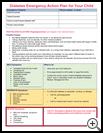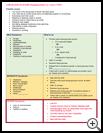
Diabetes: Insulin Pump
________________________________________________________________________
KEY POINTS
- An insulin pump is a device that delivers insulin continuously while it is connected. Most pumps use an insulin reservoir or cartridge, tubing, and an infusion set with a thin tube inserted into the skin to deliver insulin.
- The pump delivers insulin into the body more accurately than injections (shots) and may result in fewer large swings in blood glucose levels.
- When your child has an insulin pump, your child’s healthcare provider will tell you how often to check your child’s blood glucose levels. Never ignore a high or low blood glucose reading.
________________________________________________________________________
What is an insulin pump?
An insulin pump is a device that delivers insulin continuously while it is connected. An insulin pump can help keep blood glucose (sugar) levels in the target range day and night.
Most devices include:
- Pump: Most insulin pumps are about the size of a small cell phone. The pump contains a reservoir or cartridge of insulin, a pumping mechanism, battery, computer chip, and screen. They may connect to your mobile device.
- Tubing: The tubing carries insulin from the pump to the infusion set.
- Infusion set: The infusion set lets insulin flow from the pump into the skin. It is attached to the skin with a strong adhesive. On the underside of the set, a short, thin cannula, or tube, is inserted into the skin to deliver it to fatty tissue just under the skin.
Insulin may be given using a pod, which is a small device attached directly to your child’s skin. It communicates with a mobile device that displays your child’s blood glucose level and transmits the information to the pod. The pod gives your child insulin through a catheter (small tube) placed into the fatty tissue under your child’s skin.
Automated Insulin Delivery (AID) systems have a sensor to check your child’s blood glucose, and a pump that is programmed to give your child the right amount of insulin. With AID systems information about exercise and what your child eats must be entered to get the right dose of insulin at the right time.
How does the insulin pump work?
The pump delivers insulin doses in different ways:
- Basal, or background, insulin is injected continuously by the pump over 24 hours. A pump can be programmed with different hourly basal rates to meet your child’s needs for different times of the day, physical activity, eating out, illness, and sleep.
- Bolus, or on-demand, insulin is injected by the pump on command to cover the amount of carbohydrates (carbs) they are going to eat or drink. Bolus doses can also be used to treat a high blood glucose level. If your child has a high blood glucose level before eating, a bolus of insulin can bring blood the glucose level back to the target range. Read the directions for the device to learn how to give a bolus dose. For example, you or your child may need to push a button on the insulin pump.
Your child’s healthcare provider will explain how often to check or scan your child’s blood glucose levels. You or your child may need to check it at least 4 times a day. Never ignore a high or low blood glucose reading.
How is it worn?
An insulin pump can be worn in a pump case or it can be attached to a waistband, pocket, bra, sock, or underwear. Your child can tuck any excess tubing into the waistband of underwear or pants.
During sleep, the pump can be worn on a waistband, armband, or leg band.
Some insulin pumps are waterproof, but others should not be put directly in the water. In some cases, your child may need to disconnect the pump from the catheter when swimming, bathing, or showering. Check the instructions that come with your child’s pump.
When physically active, your child can wear an armband or an elastic waistband with a pump case. For some activities, your child may need to take the pump off so that your child doesn’t fall on it. Your child should not go longer than 1 hour without any insulin. Check blood glucose levels as often as advised by your child’s healthcare provider, which could be as often as every hour while the pump is disconnected. Blood glucose and ketone levels could go up while your child is not getting insulin. Your child may need to take a dose of insulin if blood glucose goes too high before reconnecting the pump.
A pod is waterproof and secured directly to your child’s skin without any external tubing. It must be disconnected and replaced with a new pod as often as directed, such as every three days.
What are the benefits of an insulin pump?
Some benefits of using an insulin pump are:
- The pump delivers insulin into the body more accurately than injections (shots) and may result in fewer large swings in blood glucose levels.
- You can program different basal rates to meet your child’s needs for different times of the day, physical activity, eating out, illness, menstruation, and sleep. This can give your child more flexibility.
- Accuracy and flexible doses can lead to greater blood glucose control, which in turn leads to fewer complications in the long term.
- Your child can adjust doses, which is helpful if your child needs to take small doses of insulin. This is especially important for small children who do not need large amounts of insulin.
- The pump lets your child reduce the number of shots needed each day because it delivers insulin continuously. The infusion set only needs to be changed every 2 to 3 days.
- The pump uses rapid-acting insulin. Rapid-acting insulin is only working when your child needs it to. This means that your child has less risk for low blood glucose (hypoglycemia).
- You and your child’s healthcare providers can download and use the information stored in the pump to make changes to your child’s treatment plan.
What are the disadvantages of an insulin pump?
The disadvantages of an insulin pump are:
- It takes time to learn to use a pump. It may take several months to get the correct basal and bolus rates figured out. During this learning period your child’s blood glucose control may not be as good as you would like.
- You need someone to help you figure out how much insulin to use, how to set different basal rates, and answer other questions you may have. If your child’s primary care provider prescribes an insulin pump, ask for a referral to a certified insulin pump trainer.
- If the catheter accidentally comes out or bends, or the tube gets kinked or clogged, blood glucose levels may get high and cause problems. Your child can also get a dangerous buildup of acids in the blood (ketoacidosis) more quickly than if your child was using insulin shots. If your child’s blood glucose is unusually high or low, it’s important to check the pump to make sure it’s working correctly.
- The cost of pump supplies is usually more than the cost of insulin, pens, and syringes even with insurance.
- Some children have skin irritation or infection where the pump or catheter is attached to the skin. Skin irritation can also happen if your child is using a continuous glucose monitor (CGM). Talk to your child’s healthcare provider about this.
- For some children, being connected to a device 24 hours a day can be bothersome.
Last modified: 2022-03-15
Last reviewed: 2022-02-05


